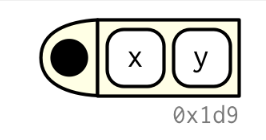6.1 How to make a simple function in R
Let’s imagine the structure of a function:

Figure 6.1: The black dot on the left is the environment. The two blocks to the right are the function arguments.
Function components
Functions have three parts, formals(), body(), and environment().
Example
coffee_ratings%>%slice(1:3)%>%select(1:5)
#> # A tibble: 3 × 5
#> total_cup_points species owner country_of_origin farm_name
#> <dbl> <chr> <chr> <chr> <chr>
#> 1 90.6 Arabica metad plc Ethiopia "metad pl…
#> 2 89.9 Arabica metad plc Ethiopia "metad pl…
#> 3 89.8 Arabica grounds for health admin Guatemala "san marc…avg_points <- function(species){
# this function is for calculating the mean
avg <- coffee_ratings %>%
filter(species == species) %>%
summarise(mean = mean(total_cup_points))
return(avg)
}body(avg_points)
#> {
#> avg <- coffee_ratings %>% filter(species == species) %>%
#> summarise(mean = mean(total_cup_points))
#> return(avg)
#> }Functions uses attributes, one attribute used by base R is srcref, short for source reference. It points to the source code used to create the function. It contains code comments and other formatting.